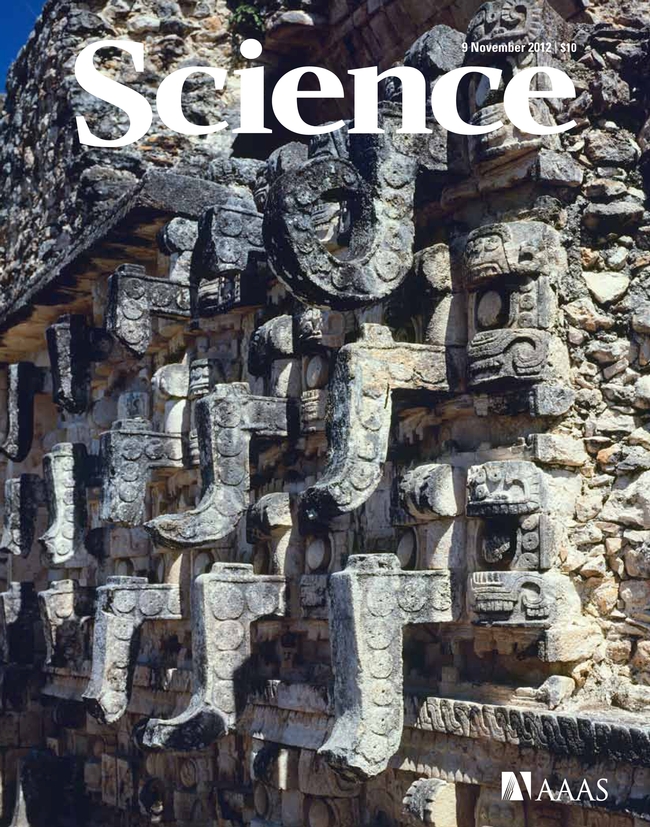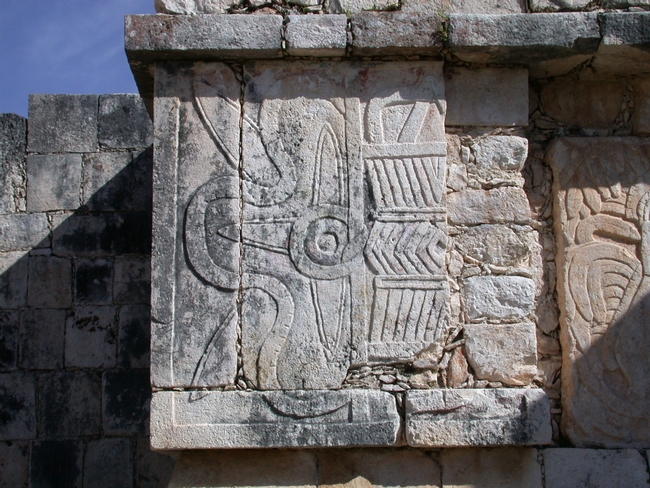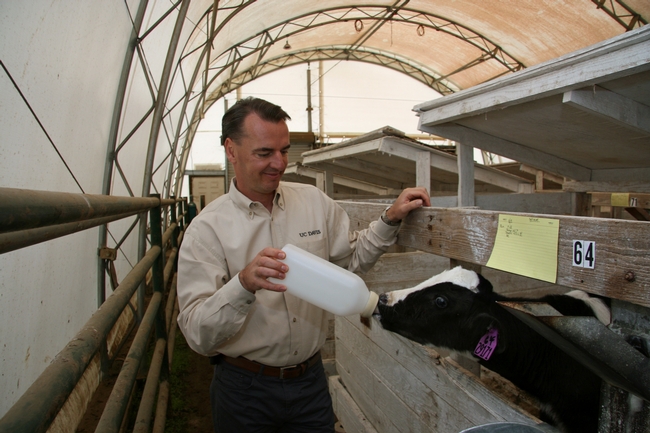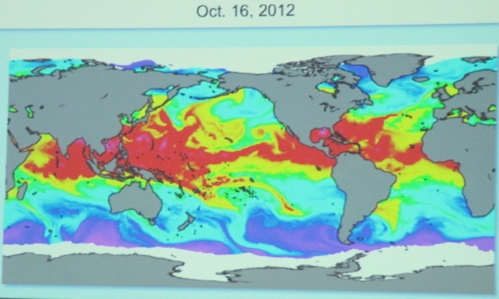Posts Tagged: Climate Change
Drought hastened collapse of Maya civilization
Decades of extreme weather crippled, and ultimately decimated, first the political culture and later the human population of the ancient Maya, according to a study by an interdisciplinary team of researchers that includes two University of California, Davis, scientists.
Now, for the first time, researchers have combined a precise climatic record of the Maya environment with a precise record of Maya political history to provide a better understanding of the role weather had in the civilization’s downfall.
Their findings are published in the Nov. 9, 2012, issue of the journal Science.
“Here you had an amazing state-level society that had created calendars, magnificent architecture, works of art, and was engaged in trade throughout Central America,” said UC Davis anthropology professor and co-author Bruce Winterhalder. “They were incredible craftspersons, proficient in agriculture, statesmanship and warfare — and within about 80 years, it fell completely apart.”
To determine what was happening in the sociopolitical realm during each of those years, the study tapped the extensive Maya Hieroglyphic Database Project, run by linguist Martha Macri, a professor of Native American studies and director of the Native American Language Center at UC Davis. Macri, a specialist in Maya hieroglyphs, has been tracking the culture’s stone monuments for nearly 30 years.
“Every one of these Maya monuments is political history,” said Macri.
Inscribed on each monument is the date it was erected and dates of significant events, such as a ruler’s birthday or accession to power, as well as dates of some deaths, burials and major battles. The researchers noted that the number of monuments carved decreased in the years leading to the collapse.
But the monuments made no mention of ecological events, such as storms, drought or references to crop successes or failures.
For that information, the research team collected a stalagmite from a cave in Belize, less than 1 mile from the Maya site of Uxbenka and about 18 miles from three other important centers. Using oxygen isotope dating in 0.1 millimeter increments along the length of the stalagmite, the scientists uncovered a physical record of rainfall over the past 2,000 years.
Combined, the stalagmite and hieroglyphs allowed the researchers to link precipitation to politics. Periods of high and increasing rainfall coincided with a rise in population and political centers between A.D. 300 and 660. A climate reversal and drying trend between A.D. 660 and 1000 triggered political competition, increased warfare, overall sociopolitical instability, and finally, political collapse. This was followed by an extended drought between A.D. 1020 and 1100 that likely corresponded with crop failures, death, famine, migration and, ultimately, the collapse of the Maya population.
“It has long been suspected that weather events can cause a lot of political unrest and subject societies to disease and invasion,” Macri said. “But now it’s clear. There is physical evidence that correlates right along with it. We are dependent on climatological events that are beyond our control.”
Said Winterhalder: “It’s a cautionary tale about how fragile our political structure might be. Are we in danger the same way the Classic Maya were in danger? I don’t know. But I suspect that just before their rapid descent and disappearance, Maya political elites were quite confident about their achievements.”
Co-authors leading the study are Douglas Kennett of Pennsylvania State University and Sebastian Breitenbach of Eidgenossische Technische Hochschule in Switzerland. The research was funded by the National Science Foundation, the European Research Council and Alphawood Foundation.
UC Davis scientist to lead UN effort to study livestock’s environmental impact
In the aftermath of Hurricane Sandy, climate change and global greenhouse emissions are a hot topic these days. Dozens of UC Davis scientists study many facets of the causes and consequences of global warming.
One of them is Frank Mitloehner, UC Cooperative Extension specialist and professor in the Department of Animal Science at UC Davis. Mitloehner has studied the role of the livestock industry in contributing to greenhouse gas emissions. Mitloehner was recently selected to chair a United Nations committee to measure and assess the environmental impacts of the livestock industry.
As chair of the new Food and Agriculture Organization of the United Nations (FAO) committee, he will lead representatives of national governments, livestock industries, nonprofits, and the private sector in establishing science-based methods to quantify livestock’s carbon footprint, create a database of greenhouse gas emission factors for animal feed, and develop a methodology to measure other environmental pressures, such as water consumption and nutrient loss.
“By the end of three years, we’ll have a methodology that’s globally accepted, that anyone in the world can use to quantify the environmental impact of their livestock,” Mitloehner said.
The FAO estimates that meat consumption will increase 73 percent by 2050 and dairy consumption will grow 58 percent over current levels. Methods of raising livestock differ throughout the world, with American producers being among the world’s most efficient. For instance, it takes approximately 20 Indian cows to produce as much milk as one dairy cow in the United States.
Mitloehner’ s research has found that livestock account for 3.4 percent of greenhouse gas emissions in the United States. The transportation sector, on the other hand, contributes roughly 26 percent.
“Transportation choices continue to be the main contribution to climate change and not, as is often depicted, food choices,” Mitloehner says. “This new program is an effort to harmonize methodologies to benchmark the environmental impact of livestock.”
Among the founding members of the committee are the governments of France, Ireland, the Netherlands, and New Zealand, as well as the European Feed Manufacturers’ Federation, the European Vegetable Oils and Proteinmeal Industry, the International Dairy Federation, the International Meat Secretariat, the International Egg Commission, the International Poultry Council, the International Federation for Animal Health, and the World Wildlife Fund.
Climate is indeed an angry beast
Global warming promises to be among the most immense challenges to human adaptation in history, as big as social media. But the climate topic has been overshadowed in recent years by the recession. Just as the Dow Jones can’t be described by the fluctuations of a single decade, climate science is not defined by periods less than centuries.
These thoughts were shared at a breakfast Oct. 16 at UC Davis hosted by Capital Public Radio. The speaker: Ben Santer, MacArthur Fellow (1998), National Academy Member (2012), and atmospheric scientist at Lawrence Livermore National Laboratory.
Santer said that when he hears about the tragedy of burdening youth with the national debt, he would like to hear more about the burdening of youth with global climate change. The verbal references have vaporized.
It was appropriate that Santer opened his talk with a graphic depicting changes in global water vapor, the greenhouse gas that Earth relies on to sustain its water cycles. This greenhouse gas inspired 10,000 years of human supplication to climate gods that could meet their need for rain. But he didn’t come to talk about the largely unpredictable weather (he calls this noise), except as an indicator of a more predictable long-term climate trend (he calls this the signal). Scientists have methods to work out the signal to noise ratio and finding the major trends among frequent short-term fluctuations.
Santer has been involved with the IPCC since 1990. It wasn’t until 1995 that this international mouthpiece of global climate science announced that the evidence suggested that there was a human influence on global climate.
To his surprise, Santer spent the next year and a half defending that cautionary statement, and his research role turned into that of a messenger. Two more IPCC reports and 17 years later, he is still confirming human influences through testimony to the U.S. House of Representatives’ Committee on Global Warming (2010). His message remains the same, “Climate science is not a scam, a hoax, or a conspiracy.” It is not a belief system, so he doesn’t have to “believe in it.” He does believe in scientific facts, and proving hypotheses. His graphics make a strong case for the science, but his research problem is one of communication. He resolved to talk to everyone he meets about it.
His advice, when asked this question from the audience, would be to make the U.S. a leader in solutions rather than a leader in finger pointing. He believes that the leaders who make economic decisions based on climate science will be better able to adapt and manage the impending change, however placing blame on other nations is counterproductive to this goal.
What can we expect from the next IPCC global climate report? Santer predicts that there will be a downsizing of scale to regional scenarios. Following sage advice, if the problem is too big, break it down. His last word, a quote from climate scientist Wally Broecker, “Climate is an angry beast and we are poking it with a sharp stick.”
Climate change will likely impact the grocery store produce aisle
- Cherries, said reporter Mark Schapiro, are the canary in the climate coalmine for California tree crops. "They're highly sensitive to changes in temperature and rainfall, which scientists say are being altered by climate change," he said.
The segment included comments from Joe Grant, UC Cooperative Extension advisor in San Joaquin County.
He said California cherry growers have traditionally had a competitive edge in the U.S. because their crop ripens early compared to cherries grown by competitors in Oregon, Washington, Michigan and New York.
"The market price for sweet cherries very early in the season is very, very high," Grant said. But now, California's moderate climate may be getting too warm, and cherry production could become unsustainable. - Water was the focus of the second part of the documentary, especially the fact that less water and limited drainage options prevent farmers from leaching salts out of crops' rootzones on the west side of the San Joaquin Valley. The salty environment for an almond grower featured in the segment has prompted him to consider uprooting the trees and replanting with rootstocks that have greater salt tolerance.
- The third segment dealt with tomato-potato psyllid, which has recently begun surviving the winter in areas where it used to be too cold. John Trumble, professor in the Department of Entomology at UC Riverside, said that, in addition to direct feeding damage, the psyllid transmits a disease in potatoes that creates zebra-like markings when they are fried to make chips.
"Some of them come out with wonderful patterns," Trumble said. "But unfortunately, what's happened, instead of starch they have sugar in the vascular system. When you cook that, it turns brown and the consumer sends it back."
View the documentary below:
Climate change fuels western wildfires
From California’s Ponderosa fire to Colorado’s record-breaking Waldo Canyon fire and other blazes burning across the West, the summer of 2012 -- like many recent summers -- has been marked by a long, intense wildfire season. It has claimed thousands of acres, hundreds of homes, and in some cases, lives.
Malcolm North, professor in the Department of Forest Ecology at UC Davis and U.S. Forest Service research scientist, studies the effects of fire on Sierra Nevada coniferous forests. In this video, North explains how climate change and a history of fuel suppression in the forest mean wildfires will burn hotter, faster, longer and more often -- indefinitely.
“I believe very strongly we’re going to have more fires, larger fires, and those fires are going to be of higher severity,” he says. “We do need to figure out a means of making the forest more resilient.”
North is principal investigator on the Teakettle Ecosystem Experiment, which is looking at the effects of fires and forest thinning on a forest ecosystem.
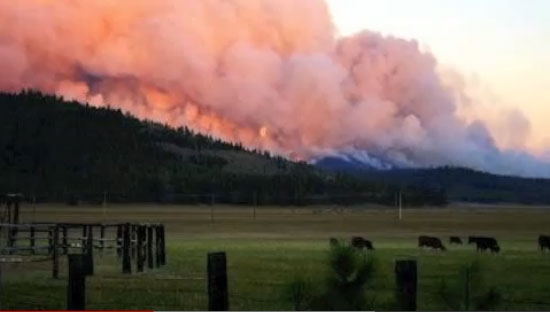
The Moonlight Fire of 2007, which burned about 70,000 acres, is an example of a high-intensity fire.


